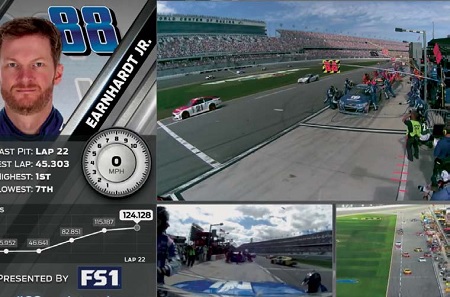Automating Multiple Platforms and Feeds
OTTAWA—Serving video to multiple distribution platforms (broadcast, Web, and mobile) using automated program playout has never been more complicated for TV broadcasters. Not only does each distribution platform come with its own unique pixel count/resolution and aspect ratio that has to be accommodated, but smartphone/tablet vendors seem to keep adding new ones whenever new products are introduced.
For automation vendors, “one of the biggest challenges is being able to serve the multitude of platforms that broadcasters need to cover,” said Karl Mehring, director of playout and delivery for SAM. “The automation systems also have to cope with non-video concerns such as metadata and QC.”

Fox Sports uses Vizrt’s compositing software engine to create Driver Channels for its Fox Sports GO app.FOX SPORTS GO
When Fox Sports wanted to jazz up its Fox Sports GO app, the network created “Driver Channels.” Using proprietary automation software created by the network and rendering into a Vizrt compositing software engine, Fox Sports keeps each channel populated with a big screen view of the race, a smaller window showing the driver selected by the viewer, and a third window that shows whichever driver is closest to the fan’s driver choice. Each Driver Channel also shows the selected driver’s photo, current speed, starting/current position, laps done, and current speed.
“This entire system is run in real-time by Fox’s automation software rendering in Vizrt; there is no human operating it,” said Zac Fields, senior vice president of Fox Sport’s graphic technology and integration. “The software will automatically switch the camera feeds being displayed based on the cars selected and their position on the track. When the driver pulls onto the pit road, the automation will switch first to a wide view pit road, then to an isolation cam that shows the driver’s car as it is being serviced.”
“Fox Sports GO’s Driver Channel is a great user experience for fans of the drivers we are featuring, as it is a dedicated viewing experience to that driver,” said Clark Pierce, Fox Sports’ senior vice president of TV Everywhere and special projects. “We have only scratched the surface and look forward to adding more features in the future to make it more immersive for fans.”
Fox Sports GO Driver Channels use Vizrt’s Viz Engine real-time graphics and video compositor to make its content work. On the automation side, Vizrt Mosart and Vizrt Opus let content creators (like news reporters) spend their time working on the live broadcast version of their content, while the automation software automatically generates and formats versions for the Web and mobile.
PRIORITIES FOR MULTIPLATFORM AUTOMATION
For broadcasters, selecting the right multiplatform automation comes down to obtaining “priority capabilities,” functions that address their most important requirements.
The professional video industry's #1 source for news, trends and product and tech information. Sign up below.
For instance, Telestream’s Vantage media processing platform “offers end-to-end process automation; right down to preparing, transcoding, and playing out format-appropriate content to broadcast, the Web, and mobile,” said Paul Turner, vice president of enterprise product management for Telestream. “This includes both SD and HD format, plus the capability for the automation software to react to embedded metadata.” Vantage will even format content for different parts of the world operating on different video standards and distribution broadcasting rules, Turner noted; “all without any need for direct human intervention after the parameters have been programmed in.”
SAM’s Momentum is an end-to-end media management and workflow automation suite that allows the various elements of multiplatform service (aspect ratio/resolution, graphics, and insertion of content specialized for one of more distribution channels) to be added into the workflow at the appropriate process points. “Users can configure Momentum to precisely align with their organization’s particular multiplatform requirements,” said Karl Mehling senior marketing manager for SAM. “Momentum can also be automatically set to do whatever transcoding and format transformations the broadcaster requires, including serving out content live and to VOD; all by itself.”
Imagine Communications’ SelenioFlex File automated multiplatform software (built using the company’s Zenium workflow manager architecture) has been designed to make keeping up with change fast and easy. “Rather than create a monolithic software package that has to be substantially upgraded or even replaced to cope with change, we have deliberately built SelenioFlex on a modular basis,” said Darren Gallipeau, SelenioFlex Files’ product manager. “When a new codec catches on in the marketplace such as HEVC, Imagine simply developed an HEVC software module that plugs into SelenioFlex File. This simple download keeps the system up-todate at minimal cost and time to our users.”
The degree of flexibility and adaptability offered by these vendors’ automation systems are precisely what today���s broadcasters need to keep up with the evolving multiplatform universe. At the same time, these systems help broadcasters keep their human resources expenses down, by automating tasks that are unavoidable cost centers. The more broadcasters can do this, the more they can survive and thrive in the world of multiplatform content distribution.
James Careless is an award-winning journalist who has written for TV Technology since the 1990s. He has covered HDTV from the days of the six competing HDTV formats that led to the 1993 Grand Alliance, and onwards through ATSC 3.0 and OTT. He also writes for Radio World, along with other publications in aerospace, defense, public safety, streaming media, plus the amusement park industry for something different.

